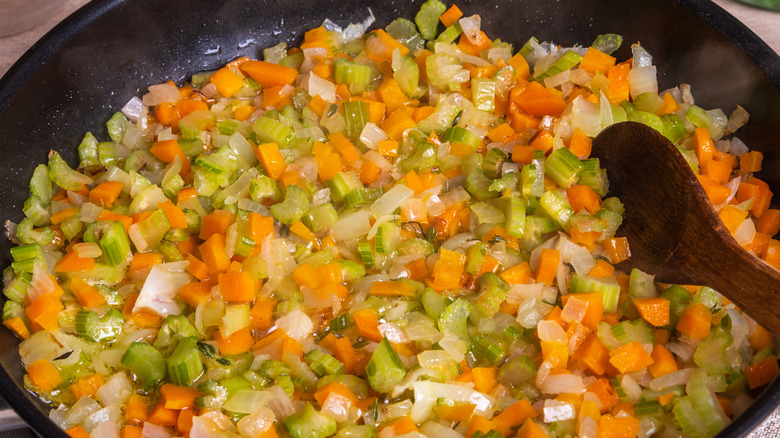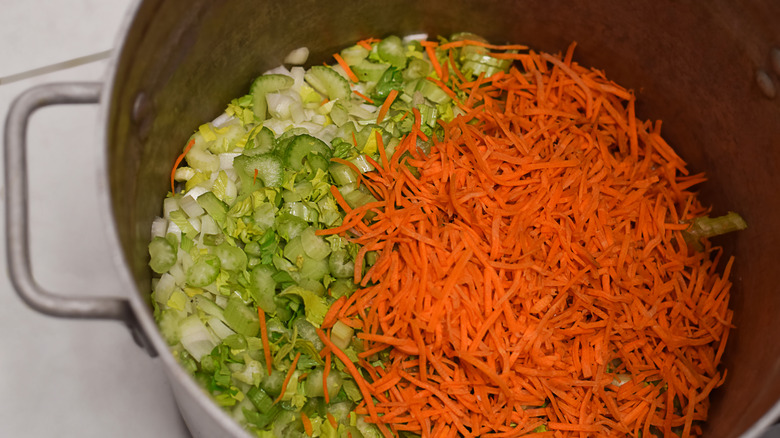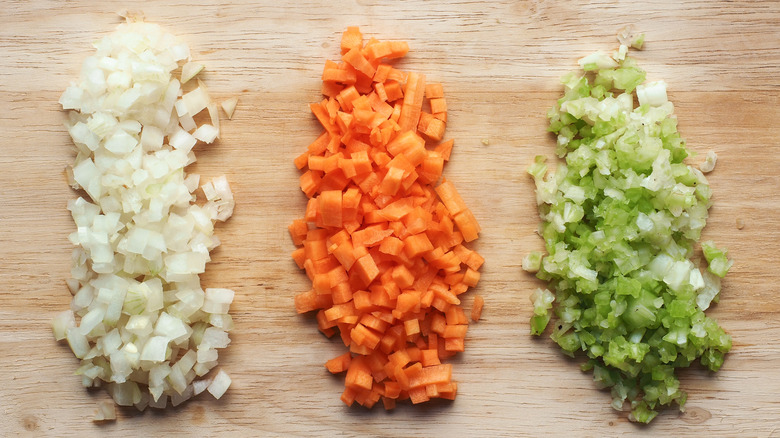Sweating Your Vegetables Is Not As Gross As It Sounds
If you've ever come across instructions in a recipe asking you to sweat your vegetables, it doesn't mean you should stand over the pot in a fit of stress and stare down at the contents. It also doesn't mean that your carefully chopped or diced onion, carrot, and celery are going to need to jump into a spin class. It's actually just a flavor-building step for lightly cooking aromatic vegetables.
If you've ever made a soup, stew, or braise — and even if the recipe doesn't specifically say "sweat" — you've probably already sweated vegetables, you just didn't know it had a name. Unlike pop songs or high-impact exercises promising to make you sweat, this cooking technique is not high energy — it's actually a slow and low kind of cooking. It's usually the first step on the stove before laying in other flavors, and it's done to give some of the crunchier, denser vegetables a head start. If your recipe calls for a mirepoix (carrot, onion, celery) or a Cajun "holy trinity" (onions, bell peppers, celery), chances are that you'll need to sweat some veggies.
How to sweat vegetables
Sweating vegetables could not be easier. In fact, the biggest mistake most people make when sweating vegetables is overthinking the process. All you need to do to sweat your base veggies is to put them in the pan with a little bit of oil or butter — a cold pan is best here to keep the temperature low — and turn the burner on medium to low. You don't want any browning on the vegetables, you just want to soften them, so keep an eye on what's going on inside the pot or pan and stir things around if any browning starts to occur. If it's too hot and the veggies are cooking too fast, turn the burner down and take the pot off the stove for a minute or two to cool down.
Properly sweated vegetables will be tender and the flavors will be more concentrated. As the vegetables cook they will release moisture, which is where this technique gets its name — it looks a little like they're sweating. You'll know you've reached peak sweat when your onions become translucent and you can smell the aromatics.
There are some important rules to follow
It's not difficult to sweat vegetables, but there are some places to troubleshoot. The most important rule is to make sure that you cut all your vegetable pieces uniformly. Good knife skills are not just for making your food look professional, if your food isn't cut into the same size pieces some will cook faster and burn while others will be undercooked.
Also, be sure to use enough fat to coat the pan so that your vegetables don't stick to the pot and caramelize. Remember, you're going for soft, not browned, veggies — otherwise your recipe would tell you to sauté. Use a spatula or wooden spoon to constantly move the pieces around in the pot to avoid hot spots and burning.
Bear in mind, your sweated vegetables are the base for the flavor of whatever you're cooking — from chicken noodle soup to tomato sauce — so set yourself up for success by always taking it slow and getting the base just right before moving on to the next step of the recipe.


